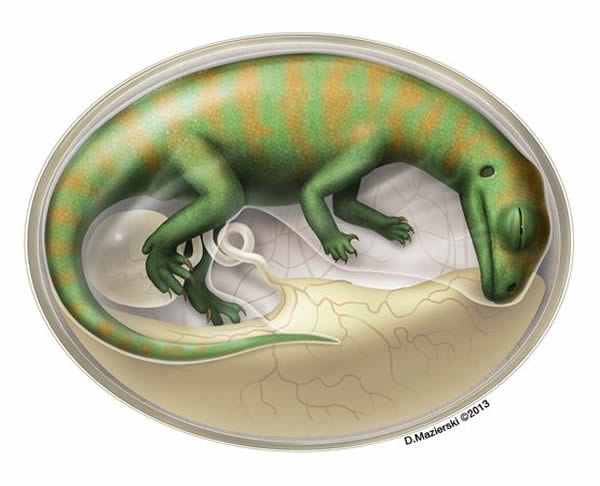Baby Dinosaurs Flexed Muscles Inside Their Eggs
Baby dinosaurs likely twitched inside their eggs to exercise developing muscles and spur bone development, according to a new study of the oldest embryonic dinosaur remains ever discovered.
With a few rare exceptions, almost all known dinosaur embryos are from the Cretaceous period, which ended 65 million years ago. But scientists recently discovered hundreds of fossilized dinosaur embryo bones in China's Lufeng County (map) that date to the lower Jurassic period and are between 190 and 197 million years old.
"These are by far the oldest embryonic [dinosaur] materials," said study leader Robert Reisz, a paleontologist at Canada's University of Toronto Mississauga.
"[But] we did not find complete eggs," Reisz noted. "It's a bone bed, which means the bones have been sorted and concentrated, and all of the eggshell materials have been broken up into little pieces."
When Reisz and his colleagues examined the fossils, they looked very porous—a telltale sign that they belonged to developing embryos. "One of the characteristics of embryonic bone is that it looks very pockmarked because it's growing very fast and the tissue surrounding it is penetrating the bone extensively with blood vessels," he explained.
In an analysis published today in the journal Nature, the team concluded that all the bones belonged to a single species of long-necked, plant-eating creature in the genus Lufengosaurus, which grew to a length of about 30 feet (9 meters) and was a common dinosaur in the region.
Embryonic dinosaurs (illustration above) likely flexed their muscles inside the egg to promote bone growth, a new study says.
Nesting Site
The scientists speculate that the Lufeng site was once located near water and was a popular nesting ground for the dinosaur.
"These animals probably liked to make their nests close to the water because it keeps the sediment in which they lay their eggs fairly moist, so the eggs don't dry out," Reisz said.
"But the danger is that the nests could be flooded, so that's what we presumed happened here: It became inundated, the embryos were smothered by sediment and water, and [they] basically rotted and fell apart."
Contractions
The researchers excavated more than 200 bones belonging to at least 20 different Lufengosaurus embryos. "The way we can tell that is we have at least 20 distinct thighbones,” Reisz explained.
The thighbones, or femurs, range in length from about half an inch to an inch (12 to 24 millimeters) long, and are from embryos at different stages of development.
When Reisz and his colleagues focused on a bone projection, or process, on the femurs where leg muscles attached—known as the fourth trochanter—from different stages of embryo growth, they found that they closely mirrored the development stages of modern animals.
That is, the tiniest femurs showed no signs of a fourth trochanter. Femurs from embryos that were a bit older had budding trochanters whose interiors were made up mostly of cartilage. And the largest, most developed femurs had big, fully hardened trochanters.
From studies of living animals such as mice, other scientists have shown that the development of trochanters and other bone processes require early muscle contraction during embryonic development.
"Lots of animals, such as birds and mammals, move inside the egg [or womb]. And of course, our babies move like crazy," Reisz said.
That's because "if the muscles don't contract, the processes on the bones do not form ... By comparison with living things, we can argue that [bone development in Lufengosaurus embryos] was also mediated by muscle contraction."
Rapid Growth
"It's really nice to have these specimens," wrote Kevin Padian, a paleontologist at the University of California, Berkeley who was not involved in the study, in an email.
"Embryonic bones of any fossil taxon are rare, and this one shows the typically rapid growth of young dinosaurs," he added. “At this stage dinosaurs grew at rates comparable to birds and mammals and much faster than other reptiles do, and they continued this rapid trajectory into adulthood.”
Reisz said further study of the embryos could yield information about the growth rate of Lufengosaurus and its relatives, the sauropods, which included some of the largest land animals to have ever lived.
"We need to do more work to be able to do that," he said. "The problem is ... we're not sure what the physiology or metabolism would have been in an animal that was neither a crocodile nor a bird, but something in between."
Ker Than
for National Geographic News
Published April 10, 2013












